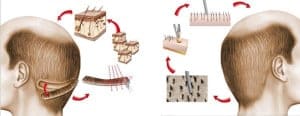How Do Hair Transplant Procedures Work?

A hair transplant is a surgical procedure in which hair is removed from one area of the scalp (called the “donor area”) and transplanted to another area of the scalp (called the “recipient site”). The goal of the procedure is to restore hair to areas of the scalp that have thinned or gone bald due to genetics, ageing, or other factors.
Hair transplants are typically done on an outpatient basis and may require several sessions to achieve the desired results. The procedure is usually performed under local anaesthesia and can take several hours (usually 5-8 hours) to complete. Most people are able to return to work within a few days of the procedure (we recommend a couple of weeks off). To see the end result, most patients need to wait around 6-7 months at a minimum. Typically a year is the time it will take for the transplanted hairs to be fully grown.
What Happens During a Hair Transplant?
The most common hair transplant method is the Follicular unit extraction (FUE). FUE is a technique for performing a hair transplant in which individual hair follicles are extracted from the donor area (the back and sides of the head) and transplanted to the recipient area (the area of hair loss) one at a time.
During an FUE hair transplant procedure, the patient is typically given a local anaesthetic to numb the donor and recipient areas. The surgeon then uses a small, specialised tool (called a punch) to extract individual hair follicles from the donor area. These follicles are then carefully transplanted to the areas of hair loss by the doctor with a little help from the team of technicians.
The FUE procedure is typically less invasive and painful than other techniques, such as follicular unit transplantation (FUT). It also tends to leave fewer scars, as the individual follicles are extracted one at a time rather than as a strip of skin. However, the FUE procedure is generally more time-consuming and may require multiple sessions to achieve the desired results.
After the procedure, the transplanted hair will fall out typically after 2-3 months. This is called the shedding phase (or ugly duckling phase). There is nothing to worry about as it’s a normal part of the procedure. The transplanted hair follicles will begin to grow back within several weeks. Most people are able to return to work and other normal activities within a couple of weeks of the procedure, but it is important to follow the doctor’s instructions for caring for the transplanted area to ensure optimal healing and results.
Types of Hair Transplant Procedures
There are a number of different types of hair transplant procedures you can choose from. Which one is appropriate for you will depend upon your hair loss situation, along with the recommendations of our hair transplant surgeons. They tend to be:
- Follicular Unit Extraction (FUE) is a tried and tested, minimally invasive hair restoration treatment in which grafts containing hair follicles are individually extracted from your donor area (typically the back and sides of your head) and are then implanted onto the areas of hair loss one by one.
- Follicular Unit Transplant (FUT) is a surgical hair restoration method (also known as the strip method) that involves excising a strip of skin from the back of your head. With this method, the follicular units are extracted from this strip and the back of your head is sewn up. These follicles are then implanted into the areas of hair loss.
- Direct Hair Implant Technique (DHI) is in essence “advanced FUE”. Hair follicles are extracted from the donor area after utilising what’s called a CHOI pen extractor with a diameter of 0.8 – 1mm. It is pretty much the same process/procedure as the standard FUE.
Which of the above methods ultimately represents the right one for you will depend on how bald you are, what you’re hoping to achieve with your results, and what your budget is. To better determine which would be the best possible option for your unique situation, fill out our form to get a free consultation with a hair implantation specialist today.
We will also provide you with a competitive quote on the treatment you need. From there, we can move forward together and determine a course of action.
Patient Testimonials
Aside from achieving fantastic results, we believe that keeping in touch with our patients before, during and after their hair transplantation procedure is paramount – it helps to keep our patients feeling calm and in control. We’re always on hand to provide guidance, support and aftercare advice. Time and again, our patients tell us that this is what sets us apart from other clinics.
You can read our great reviews of FUE hair transplants over on Google and TrustPilot




